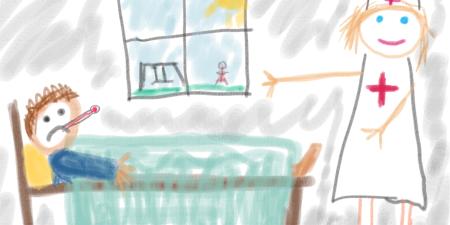In this issue of Virtual Mentor, we explore the world of pediatric critical care and emergency medicine. Medical emergencies are high-stress, fast-paced situations in which life-or-death decisions are routinely made. When these situations involve children, a number of factors amplify the ethical challenges that physicians may encounter.
Decision making in pediatrics is strikingly different than it is in adult medicine. In a pediatric intensive care unit or emergency department, parents often bear the burden of making medical decisions for their children because they are considered the natural guardians of their children’s best interests. This month’s case commentaries examine circumstances in which that presumed decision making role is impeded. Edwin Forman, MD, and Rosalind Ladd, PhD, explain “slow codes,” when physicians attempt to bypass parental decision making, often with good intentions, and apply their own decisions to a child’s end-of-life care. Philip J Rettig, MD, evaluates a situation in which a minor patient refuses a needed exam and no parent is present to aid in decision making. Jalayne J. Arias, JD, MA, and Kathryn L. Weise, MD, MA, discuss a complex case of nonaccidental trauma in which parents are suspected of putting their own interest ahead of their child’s.
Decision making for critically ill pediatric patients can also be complicated by the differing levels of development and autonomy among those under the age of legal majority. In the health law section, Valarie Blake, JD, MA, reviews several landmark court cases in which gravely ill teenagers sought to refuse potentially life-saving treatment. In the medicine and society section, Margaret Moon, MD, MPH, discusses the historical and social progression that has led to the manner in which our society designates the services, including emergency care, to which adolescents may consent without parental supervision. This month’s excerpt of the AMA Code of Medical Ethics gives guidance on how physicians should proceed when adolescents request such care.
The ethics of research and training in the pediatric critical care setting are uniquely challenging. Critically ill children require complex interventions that should be performed by skilled practitioners, which means balancing the training of new intensivists with the risk to the present patients. In the medical education section, Traci A. Wolbrink, MD, MPH, and Jeffrey P. Burns, MD, MPH, identify the ethical concerns inherent in teaching trainees to perform procedures on critically ill children and offer emerging solutions to some of these dilemmas.
Likewise, research involving children is needed to advance medical knowledge, but the informed consent process can be hard on parents who might feel coerced into participation because they fear for the lives of their children. In the first of our policy articles, Tracy Koogler, MD, reviews the legal and ethical framework for research involving critically ill children.
Born of a need for postoperative care following the advent of new surgical techniques, the pediatric intensive care unit functions largely thanks to innovations such as mechanical ventilation, extracorporeal membrane oxygenation, and renal replacement therapy. Many of the newest technologies are employed in particular clinical situations without formal FDA approval, since pediatric interventions are often slower to be approved than those for adults. While these technologies often improve outcomes for the sickest of children, they also frequently pose new ethical challenges for physicians. In the state of the art and science article, Naomi T. Laventhal, MD, MA, John D.E. Barks, MD, and Scott Kim, MD, PhD, discuss off-label use of therapeutic hypothermia for preterm infants with hypoxic-ischemic encephalopathy.
Finally, pediatric critical care and emergency medicine are environments in which tragedies occur with unfortunate frequency. The child’s pain and suffering, the parents’ distress, and the pressures on the medical team combine to make caring for children in life-threatening situations intensely difficult. With these emotions come efforts to ease the suffering of our patients, but such efforts are often accompanied by ethical challenges that are well known to all providers who have participated in end-of-life care. In our second policy article, Armand H. Matheny Antommaria, MD, PhD, and Brent Kaziny, MD, explain ethical dilemmas that arise in disaster preparation and potential methods for allocating limited resources when the number of affected children exceeds the capacity to provide aid. In the journal discussion section, Wynne Morrison, MD, MBE, clarifies opposing views expressed in the recent debate in the critical care literature about the provision of general anesthesia before extubation when a patient is not expected to survive.
Although a single journal issue is only able to scratch the surface of the myriad ethical dilemmas relating to care of the sickest children, readers will find articles that illustrate the broad variety of concerns that can and do occur in pediatric critical care and emergency medicine. We are lucky to have contributions from a distinguished group of authors who have shared excellent insights. Although even the most expert opinions often differ when it comes to ethical dilemmas, it is clear in this collection that the common thread among the authors is a desire to provide the most compassionate care possible to the sick children who are their patients. I am hopeful that readers will remain ever mindful of this unifying goal as they read these articles and apply their lessons to the care of their own patients in the future.



